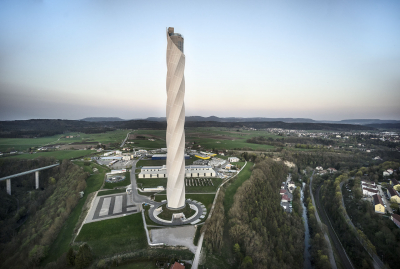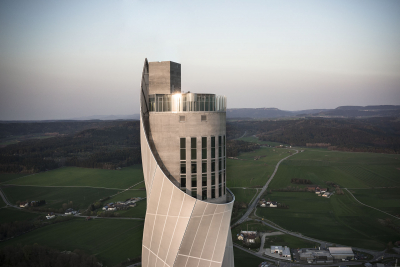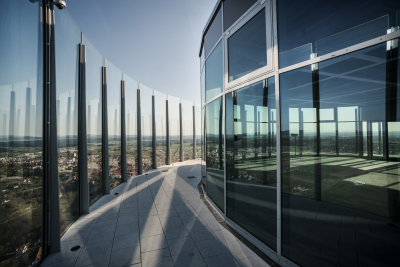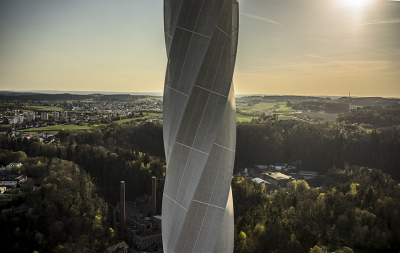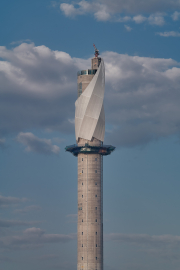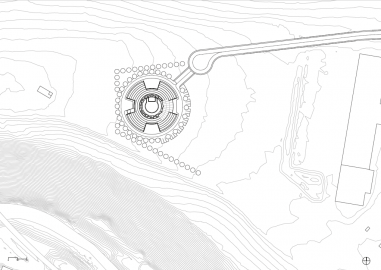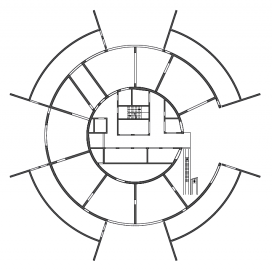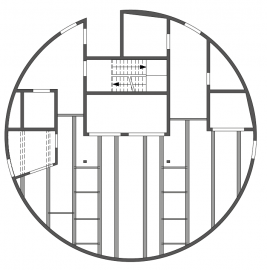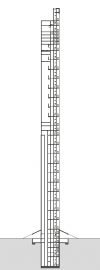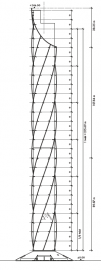ThyssenKrupp Test Tower
The ThyssenKrupp test tower is used to test and certify high-speed elevators. It thus contributes considerably towards reducing the development time of future skyscrapers throughout the world, including those presently in the design phase. Moreover a visitors’ viewing platform (Germanys highest) offers 360° views of the region from a height of 232 m.
The thyssenkrupp Test Tower (TKT) is located in the historical town of Rottweil, one of Germany’s oldest urban agglomerations, dating back to Roman times. Rottweil is particularly famous for its medieval towers and spires. The landscape around Rottweil is dominated by the lush hill country of the high plain between the Black Forest and the Swabian Alb. The high-rise building itself is highly visible from within a radius of 15-20 km. Given this particular urban and scenic setting, a sensitive design of the tower’s overall shape and especially of its façade was particularly important. Rising to a height of 246 m the ThyssenKrupp test tower in Rottweil is one of Germany’s tallest structures.
The main design idea behind the thyssenkrupp Test Tower was the creation of a highly efficient technical structure that at the same time enhances its surrounding by its sculptural qualities. The tower was to unite high visibility and instant recognizability. It was to blend into the surrounding landscape, while also enriching it by its character as a unique landmark.
Given the project’s very tight frame with regard to time and budget, the design process from the very begin-ning required a close cooperation between the architect, the engineers and the general contractor. At the same time, there had to be a continuous exchange with municipal authorities and the general public in order to ensure that the project could be realized in such outstanding surroundings. Public acceptance was particularly important; this could be secured by an open communication process involving several public consultation hearings as well as regular updates of the general public on the status quo of the project.
Since its opening, the ThyssenKrupp Test Tower has already attracted more than 200,000 visitors. It has provided an enormous boost in publicity and becoming an integral part of the town’s historic skyline.
For the simulation of various wind and/or earthquake loads an active pendulum is suspended at a height of 200 metres on cables of approximately 9 metres in length. The pendulum can be used actively to make the tower oscillate on purpose. This making the tower the only high-rise building in the world that can deliber-ately be made to oscillate.
The structure consists of a thin reinforced concrete hollow tube with a diameter of 20.80 m. The wall thickness tapers from 40 cm at the bottom to 30 cm at the top. Due to the highly effective supporting structure the maximum horizontal deformations resulting from wind loads are a mere 331 mm, corresponding to a ratio of L/725.
The facade is the tallest textile-clad building in the world. Designing and engineering this facade was a particularly demanding challenge. It not only involved taking such questions as installation and wind loads into account, but also required the consideration of diverse aspects of maintenance, weather resistance, etc. This necessitated numerous coordination meetings with various contractors as well as a range of tests, material evaluations and experimental assemblies. The envelope consists of a PFTE coated glass-fibre mesh. The facade’s spiral arrangement influences the vortex shedding and minimises the stress from lateral oscillation by approximately 40 per cent (thus leading to a reduction of 15 per cent in the amount of steel and concrete). The facade also shades the tower shaft, thus reducing the stresses induced by solar radiation.

